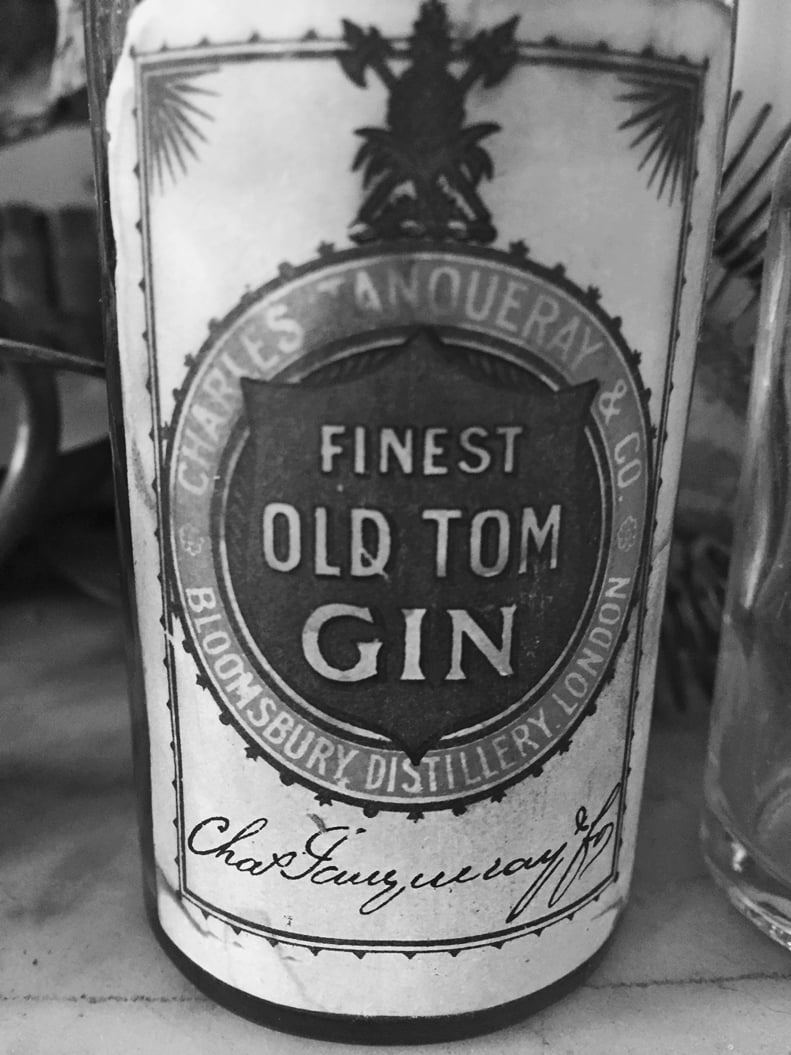Old Tom gin is a style of sweetened English gin prevalent in the nineteenth century. Old Tom has been poorly understood, and the name has been applied by modern authorities to all sweetened English gin of the period. In fact, the term denoted only the strongest sweetened gin legally available.
Old Tom was neither a distiller’s style nor (in general) a rectifier’s one, as it has been presented, but rather a retailer’s one. See rectifier (occupation). Before the rise of distillery bottlings in the late nineteenth century, vintners and publicans bought their gin from the rectifiers unsweetened, at one of two fixed proofs: either 17 or 22 degrees under proof Sikes (47.4 percent or 44.6 percent ABV; these ultimately represented proof spirit—50 percent alcohol by weight—diluted with either one-sixth or one-fifth additional water). This was generally turned into “cordial gin” (a term dating back at least to 1757) by adding water and sugar to it. Each retailer customarily offered cordial gin at several prices, according to which proof it started at and how much it had been reduced. Old Tom began as the stronger base gin and had the least added sugar and water. For a cordial gin, therefore, it was (as it was often advertised) “the strongest allowed to be sold,” with a strength of well over 40 percent ABV, where the average for all sweetened gins was around 37 percent, and some were sold as low as 22 percent. Sugar levels for Old Tom seem to have been around 35 grams per liter.
Old Tom is often listed as an eighteenth-century style of gin. It first appears in print, however, only in 1810, when it is mentioned in passing in the sporting pages of a London newspaper as a superior grade of gin. It begins appearing in vintners’ advertisements in 1812, although it did not achieve wide usage for another decade or so.
Among the origin stories for Old Tom are a pair of notices from Notes and Queries in 1860 and 1868, claiming that its name refers to Thomas Chamberlain, distillery manager for the London rectifier Hodges, who kept a special grade of gin for prize customers, and that it was popularized by one Thomas Norris, an ex-Hodges employee who sold that grade under the name “Old Tom” at his public house in Russell Street, Covent Garden. This story has not received the credence it deserves, as it checks out in almost every respect.
Benjamin Hodges (1749–1827), his son, and his grandson were gin rectifiers in London from 1780 until 1870, and Thomas Chamberlain was in fact a partner in the firm from the late 1790s until his death in around 1814. Their firm was described in 1859 as the foremost “of its kind in England.” The early and widespread association between Hodges and Old Tom is well documented, and indeed the company even went so far as to bottle and export its own version of the gin, something very rarely done until the 1880s. As for Norris, he did indeed sell Hodges’s gin at his Antelope tavern (not in Russell Street but just steps away in White Hart Yard), although he did not assume ownership until the late 1810s. It is not known where he was before that.
Old Tom survived the transition to distillery bottling in the 1880s, by which time it had begun securing a reputation in the United States and was used in many new mixed drinks, including the Martini and the Gin Fizz. See Martini and Gin Fizz. The next decade, however, saw a public move toward drier drinks, and its importance began to fade. By the late twentieth century, it was essentially unavailable as a commercial product. It was prominent, however, among the old spirits revived in the cocktail renaissance, with Hayman’s Old Tom, from London, reaching market in 2007 and Ransom Old Tom, from Oregon, the next year. See cocktail renaissance. As of this writing, there are at least a dozen gins on the market worldwide calling themselves “Old Tom,” with varying degrees of justification, including an important and accurate one from Tanqueray. See Tanqueray Gordon & Co. and Gordon’s.
See also gin.
“The Factories of the South: Hodges Distillery.” Lambeth and Southwark Advertiser, June 18, 1859, 3.
“Greenwich.” Kentish Chronicle, April 27, 1810, 2.
“Old Tom.” Notes and Queries, July 7, 1860, 9.
“Old Tom Gin.” Notes and Queries, March 28, 1868, 298.
By: David Wondrich

